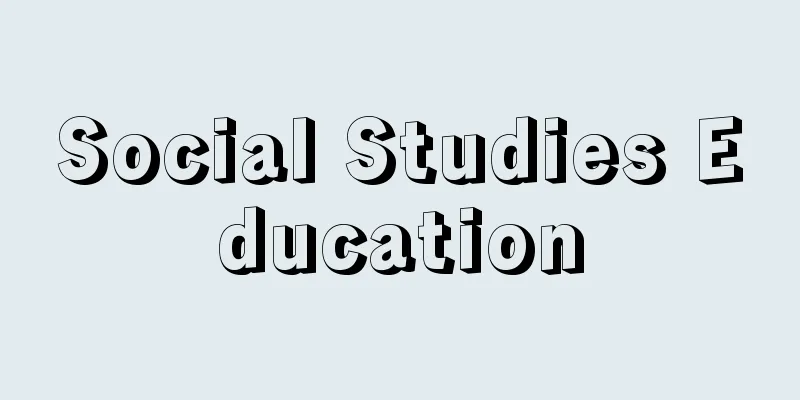Social Studies Education

|
Social studies is a subject that helps young people understand social life, and develops the abilities and attitudes to adapt well to society and contribute to its better development. Therefore, social studies education (also called social awareness education) can be said to be education that cultivates desirable qualities as members of society by forming correct social awareness in children. These qualities as members of society are called civic qualities or citizen qualities, and refer to the qualities necessary for those who build a democratic and peaceful nation and society. [Nagai Shigeru] developmentThis type of education was taught in Japanese schools before World War II in subjects such as moral education, geography, history, and civics, although it had a strong nationalistic and militaristic tendency. After the war ended, the Civic Education Reform Committee was established within the Ministry of Education (now the Ministry of Education, Culture, Sports, Science and Technology) to seek a new direction for civic education in order to democratize education. Also, with the suggestion of the Supreme Commander for the Allied Powers (GHQ), the Ministry of Education established the Social Studies Committee in 1946 (Showa 21). At that time, the nature and content of social studies were based on American social studies, particularly the progressive Virginia Plan and California Plan. Social studies was launched with the implementation of the new school system (6-3-3 system) in 1947 (Showa 22). The Social Studies Committee prepared the Social Studies Curriculum Guidelines and published the nature, content, and methods of the new social studies as a tentative plan. According to this, elementary school social studies would be integrated without distinctions between subjects such as geography and history, a comprehensive course called "General Social Studies" would be established for all grades in junior high school and the first year of high school, and four elective subjects, "Human Geography," "Oriental History," "Western History," and "Current Affairs," would be established for the second and third years of high school. Social studies was considered to be a subject that basically respected the life experiences, autonomy, and spontaneity of children and students, and placed emphasis on learning to solve problems centered on the local community, and the specific content and teaching methods were left to the discretion of the schools in each school. However, this social studies was so different in nature from traditional subjects such as moral education, history, and geography that it caused considerable confusion in the field of education. As a result, social studies was criticized in various ways by political and academic circles, as well as by private educational organizations, for ignoring the realities of Japanese society, lowering academic ability, etc. In response, the Ministry of Education, while acknowledging that the basic aims of social studies were correct, acknowledged the shortcomings of the curriculum guidelines and began revising them, issuing a revised version in 1951 (Showa 26). Since then, in response to changes in the domestic and international situations, the curriculum guidelines were revised in succession: junior and senior high schools in 1956 (Showa 31), elementary and junior high schools in 1958, high schools in 1960, elementary schools in 1968, junior high schools in 1969, high schools in 1970, elementary and junior high schools in 1977, and high schools in 1978. Then, from the 1950s onwards, the so-called "Japanization of social studies" progressed, and the character of social studies changed from the American style of life-ism, empiricism, and integrism to systematism, intellectualism, and subject-based (subject-based)ism. "Moral studies" was separated from social studies, and the study of history and geography was further strengthened. The name of the subject "social studies" was maintained, but in junior and senior high schools, the tendency to branch out into different fields became stronger. However, amid these trends, it was noteworthy that the high school curriculum guidelines revised in 1978 newly established "Modern Society" as a basic, comprehensive, compulsory subject for first-year high school students. [Nagai Shigeru] Contents1977 RevisionAs we have already seen, in Japanese school education, the standards for the goals and content of each subject are set out in the Course of Study issued by the Minister of Education, Culture, Sports, Science and Technology (former Minister of Education), and textbooks are also supposed to follow these guidelines. The content of social studies according to the 1977 revised Course of Study (issued in 1977 for elementary and junior high schools, and in 1978 for high schools) is roughly as follows: In the lower grades of elementary school (1st and 2nd grade), children learn about social phenomena that are familiar to them, such as school life, home life, and occupations seen in daily life. In the middle grades (3rd and 4th grade), children learn about the natural environment, historical environment, production and consumption life, and regional ties in local communities such as cities, towns, villages, and prefectures. In the 5th grade, they mainly learn about the geographical environment of our country, and in the 6th grade, they learn the basics about our country's history, traditions, and political functions. In junior high school, as a general rule, students study geography (world geography and Japanese geography) and history (mainly Japanese history, but also related world history) in parallel in their first and second years, and then in their third year they study civics (mainly the study of the Japanese Constitution, the essence of democracy, the structure of the national economy, social welfare, trade and international cooperation, the characteristics of democratic politics, peace and the international community, etc.). As mentioned above, in high school, the compulsory subject of "Contemporary Society" is placed in the first year, where students learn about the basic issues of modern society and how people should live in modern society. In the second and third years, students study "Japanese History," "World History," "Geography," "Ethics," and "Politics and Economics" as elective subjects. [Nagai Shigeru] 1989 RevisionIn accordance with the policy of improving the curriculum proposed by the Curriculum Council in December 1987, the Ministry of Education announced new curriculum guidelines for elementary, junior high and senior high schools in March 1989. As a result, a new subject called "Life Studies" was introduced in the lower grades of elementary school, and the previous lower grades of social studies and science were abolished. The existing social studies subject in senior high schools was also reorganized, with new subjects called "Geography and History" (Geography and History) and "Civics" added, and the compulsory subject "Contemporary Society" was eliminated. As a result, the only subject in social studies education that remained was "Social Studies" in the middle and upper grades of elementary school and "Social Studies" in junior high school (a three-subject system consisting of geography, history and civics), and the subject name "Social Studies" in senior high schools was abolished. The Geography and History course is a subject that deepens students' understanding and awareness of the history and geography of our country and the world, and cultivates the necessary self-awareness and qualities to be a member of a democratic, peaceful nation and society that can play an active role in the international community. It is made up of six subjects: World History A, World History B, Japanese History A, Japanese History B, Geography A, and Geography B. Two subjects are compulsory: one from World History A and B, one from Japanese History A and B, and one from Geography A and B, while the rest are elective subjects. In other words, the distinctive feature of this subject is that World History is compulsory, in terms of the internationalization of education in response to the progress of the internationalization of society. The Civics course is a subject that aims to develop the civic qualities necessary for those who will build a democratic and peaceful nation and society by helping students understand modern society from a broad perspective and becoming aware of their way of being and living as human beings.It consists of three elective subjects: Modern Society, Ethics, and Politics and Economics. The 1989 revision of the Course of Study, which can be seen as a major restructuring of Japan's postwar social studies education, did not mean the dismantling of social studies education itself. Rather, it can be said to be a reorganization of social studies education, taking into account the developmental characteristics of children and students, placing greater emphasis on the specialization and systematic nature of each subject, and aiming to cultivate well-rounded individuals who can respond independently to changes in society. [Nagai Shigeru] 1998 RevisionAbout 10 years after the 1989 (Heisei 1) revision, new curriculum guidelines were announced for elementary and junior high schools in 1998 (Heisei 10), and for high schools in 1999 (fully implemented for elementary and junior high schools in 2002, and for high schools in 2003). These curriculum guidelines are said to be aimed at improving the educational curriculum to be appropriate for the 21st century, by promoting lessons and learning that make use of the characteristics of each school, such as reducing class time by fully implementing a five-day school week, carefully selecting educational content, flexibly organizing the curriculum, introducing "comprehensive learning" that goes beyond the boundaries of subjects (such as international understanding, the environment, welfare, etc.), and enhancing "information" education, with the aim of nurturing students' ability to learn on their own and the "ability to live" resiliently with "leisure." However, although the various subjects related to social awareness in elementary, junior high, and high schools (life studies, social studies, history and geography, and civics) have undergone significant revisions, such as reorganizing and selecting the content and expanding the elective options, their basic nature and structure have not changed significantly from the 1989 revised curriculum guidelines. [Nagai Shigeru] assignmentThe history of the development of social studies or social awareness education is a good example of the problems society faces and the issues that need to be resolved. As social studies education is a subject education for the development of human beings, which aims to develop a scientific and comprehensive understanding of society and the civic qualities of desirable members of society, it must absorb the results of the ever-advancing humanities and social sciences and always respond to changes and developments in society. For this reason, the goals, contents, and methods of social studies education need to be constantly researched both theoretically and practically. Furthermore, there is an even greater demand today for organizing and systematizing these theories and practices, and for social studies education, including life studies, social studies, history, and civics, to be established as social studies pedagogy or social awareness pedagogy. [Nagai Shigeru] "Theory and Practice of Social Awareness Education - Principles of Social Studies Education" edited by Utsumi Iwao (1971, Aoi Shobo)" ▽ "Enlarged Edition of the Complete Works of Education 8: Social Awareness" edited by Nagasaka Tango, Kamishima Jiro, et al. (1975, Shogakukan)" ▽ "Exploring Social Awareness Education" edited by the Social Awareness Education Research Group (1978, Daiichi Gakushusha) " ▽ "Modern Education 6: Social Studies Education" edited by Nagai Shigeo, Hirata Yoshizo, Miyawaki Yozo (1979, Minerva Shobo)" ▽ "Research on the History of Early Social Studies Practice" edited by Hirata Yoshizo and the Early Social Studies Practice History Research Group (1986, Education Publishing Center)" ▽ "Theory and Practice of Social Studies Education" edited by the Social Studies Education Division of the Research Meeting of Faculty and Faculty of Teacher Training Universities (1988, Toyokan Publishing)" ▽ "Forty Years of Social Studies Education: Issues and Prospects" edited by Professor Kaji Tetsuo and Professor Yokoyama Jushio Retirement Commemorative Publishing Committee (1989, Meiji Tosho Publishing)" ▽ "Theory of Social Studies Education" edited by the Society for Social Awareness Education (1989, Gyosei) ▽ "Basic Knowledge of 300 Important Terms in Social Studies" edited by Moribun Koji and Katagami Souji (2000, Meiji Tosho Publishing) [Reference items] | | | | | | | |Source: Shogakukan Encyclopedia Nipponica About Encyclopedia Nipponica Information | Legend |
|
社会科とは、青少年に、社会生活について理解させ、社会によく適応し、社会のよりよい発展に寄与できる能力や態度を養う教科である。したがって、社会科教育(社会認識教育ともいう)とは、正しい社会認識を子供たちに形成させることを通して、社会人としての望ましい資質を育成する教育であるといえる。この社会人としての資質は、市民的資質とか公民的資質とかよばれ、民主的で平和な国家・社会の形成者として必要な諸資質を意味する。 [永井滋郎] 発展このような教育は、第二次世界大戦前の日本の学校教育では、国家主義的、軍国主義的傾向を強くもちつつも、修身、地理、歴史、公民などの諸教科で行われていた。大戦の終結により、教育民主化のため、文部省(現文部科学省)内に公民教育刷新委員会が設けられて、新しい公民教育の方向が求められた。また、連合国最高司令部(GHQ)の示唆もあって、1946年(昭和21)文部省は、社会科委員会を設置した。このとき、社会科の性格や内容については、アメリカ合衆国の社会科(ソーシャル・スタディーズsocial studies)、なかでも進歩的なバージニア・プランやカリフォルニア・プランなどが参考にされた。 1947年(昭和22)新学制(六・三・三制)の施行とともに社会科が発足した。社会科委員会は、学習指導要領社会科編を作成して、新しい社会科の性格、内容、方法を試案として公表したのである。これによれば、小学校の社会科は、地理、歴史などの教科目の区別を廃して統合的な学習を行い、中学校の全学年および高等学校第1学年には「一般社会」という総合的な課程を置き、高等学校第2、第3学年で「人文地理」「東洋史」「西洋史」「時事問題」の4選択科目を設けた。そして社会科は、基本的に児童・生徒の生活経験や自主性、自発性を尊重し、地域社会中心の問題解決学習を重視する教科と考えられ、具体的な内容編成や指導法は現場の学校にゆだねられたのであった。しかし、この社会科は、従来の修身、歴史、地理などとあまりにも性格を異にしていたので、教育現場に少なからぬ混乱を引き起こした。そのため、政界や学界、あるいは民間の教育諸団体などから、社会科は日本社会の現実を無視しているとか、学力を低下させたとか、いろいろの批判が投げかけられた。そこで、文部省は、社会科の基本的なねらいは正しいとしながらも、学習指導要領の不備を認めて、その改訂に着手し、1951年(昭和26)に改訂版を出した。 以後、国内、国外情勢の変化に対応して、1956年(昭和31)中・高校、58年小・中学校、60年高校、68年小学校、69年中学校、70年高校、77年小・中学校、78年高校と、相次いで学習指導要領の改訂が行われた。そして昭和30年代以降、いわゆる「社会科の日本化」が進み、生活主義、経験主義、総合主義というアメリカ的社会科から、系統主義、主知主義、教科(科目)主義へと性格を変えていった。「道徳」が社会科から分離独立し、歴史、地理学習がいっそう強化された。「社会」という教科の名称は維持されたが、中学校、高等学校にあっては分科的傾向が濃厚となった。しかし、このような動向のなかにあって、78年度改訂の高等学校学習指導要領が、高校1年に、総合的な性格をもった基礎的な必修科目として「現代社会」を新設したのは、特筆すべきことであった。 [永井滋郎] 内容1977年の改訂すでにみてきたように、日本の学校教育では、各教科の目標、内容等の基準は、文部科学大臣(旧文部大臣)が告示する学習指導要領によって示され、教科書もこれに従うことになっている。1977年改訂の学習指導要領(小学校・中学校は1977年、高等学校は78年に告示)による社会科の内容はほぼ次のようである。 小学校低学年(1、2年)では、学校生活、家庭生活、日常生活にみられる職業など、子供の身近な社会事象について学習する。中学年(3、4年)では、市・町・村・県など、地域社会の自然環境、歴史的環境、生産・消費生活、地域の結び付きなどを学習し、第5学年で、主としてわが国土の地理的環境、第6学年で、わが国の歴史・伝統や政治の働きに関して基礎的な学習を行う。 中学校では、原則として、第1学年と第2学年で地理的分野(世界地理と日本地理)、歴史的分野(日本史を中心に、関連する世界史を含む)を併行して学習し、そのうえにたって、第3学年で公民的分野(日本国憲法の学習を中心に、民主主義の本質、国民経済の仕組み、社会福祉、貿易と国際協力、民主政治の特色、平和と国際社会など)を学ぶ。 高等学校では、前述したように、必修科目としての「現代社会」が第1学年に置かれ、現代社会の基本的な問題と現代社会における人間の生き方について学習し、第2、第3学年で、「日本史」「世界史」「地理」「倫理」「政治・経済」を選択科目として学ぶ。 [永井滋郎] 1989年の改訂1987年(昭和62)12月の教育課程審議会答申の教育課程改善の方針に従い、89年(平成1)3月、新しい小・中・高等学校の学習指導要領が文部省から告示された。これによって、小学校低学年に「生活科」が新設され、それまでの低学年の社会科と理科はなくなった。また、従来の高等学校社会科も再編成されて、新しく「地理歴史科」(地歴科)と「公民科」とが設けられ、必修科目「現代社会」は姿を消した。したがって、社会科教育としての教科「社会」は、小学校の中・高学年「社会」と中学校「社会」(地理、歴史、公民の3分野制)のみとなり、高等学校社会(科)の教科名はなくなった。 「地理歴史科」は、わが国および世界についての歴史的、地理的な理解と認識を深め、国際社会で主体的に生きる民主的、平和的な国家・社会の一員として必要な自覚と資質を養う教科であり、「世界史A」「世界史B」「日本史A」「日本史B」「地理A」「地理B」の6科目で構成され、「世界史A・B」のうち1科目、ならびに「日本史A・B」、「地理A・B」から1科目の計2科目を必修とし、ほかは選択科目となった。すなわち、社会の国際化の進展に対応する教育の国際化という点で、「世界史」が必修となったところにこの教科の特色がみられる。 「公民科」は、広い視野にたって現代の社会を理解させ、人間としてのあり方・生き方を自覚させることによって、民主的、平和的な国家・社会の形成者に必要な公民的資質を養う教科で、「現代社会」「倫理」「政治・経済」の3選択科目で構成されている。 以上のようなわが国戦後社会科教育の大改編とみられる1989年の学習指導要領の改訂は、社会科教育そのものの解体を意味するのではなく、児童、生徒の発達上の特徴をよく踏まえ、各教科の専門性や系統性をいっそう重視し、社会の変化に自ら対応できる心豊かな人間の育成を目ざして、社会科教育が再編成されたものであるといえる。 [永井滋郎] 1998年の改訂1989年(平成1)の改訂から約10年を経て、さらに新しい学習指導要領が98年(平成10)に小・中学校、99年高等学校に告示された(小・中学校は2002年、高校は2003年に全面実施)。この学習指導要領は、学校週5日制完全実施による授業時間の縮減、教育内容の厳選、教育課程の弾力的編成、教科の枠を越えた「総合的な学習」(たとえば国際理解、環境、福祉など)の導入や「情報」教育の充実など、各学校の特色を生かした授業・学習を推進し、児童・生徒の自ら学ぶ力と「ゆとり」をもってたくましく「生きる力」を育成することをねらった、21世紀にふさわしい教育課程の改善を目ざしたものとされる。 しかし、小・中・高校の社会認識にかかわる諸教科(生活科・社会科・地歴科・公民科)は、学習内容の整理・精選、選択制の拡大などでかなりの修正が加えられたものの、その基本的な性格や構造においては、1989年改訂学習指導要領との大きな変化はみられない。 [永井滋郎] 課題社会科ないし社会認識教育の発展の歴史は、社会が当面する諸問題および解決すべき諸課題をよく物語っている。社会科教育は、科学的で総合的な社会認識と望ましい社会人としての市民(公民)的資質を育成するという、人間形成のための教科教育であるだけに、日進月歩する人文・社会諸科学の成果をよく摂取するとともに、つねに社会の変化・発展に即応していかねばならない。このため、社会科教育の目標、内容、方法については、理論的にも実践的にも絶えず研究が重ねられていく必要がある。さらに、それらの理論や実践を整理し、体系化し、生活科・社会科・地歴科・公民科を含めた社会科的な教育を社会科教育学もしくは社会認識教育学として確立していくことが、今日いっそう強く要請されるのである。 [永井滋郎] 『内海巌編著『社会認識教育の理論と実践――社会科教育学原理』(1971・葵書房)』▽『長坂端午・神島二郎他編『増補版教育学全集8 社会の認識』(1975・小学館)』▽『社会認識教育研究会編『社会認識教育の探求』(1978・第一学習社)』▽『永井滋郎・平田嘉三・宮脇陽三編著『現代の教育学6 社会科教育学』(1979・ミネルヴァ書房)』▽『平田嘉三・初期社会科実践史研究会編著『初期社会科実践史研究』(1986・教育出版センター)』▽『教員養成大学・学部教官研究集会社会科教育部会編『社会科教育の理論と実践』(1988・東洋館出版社)』▽『梶哲夫先生・横山十四男先生退官記念出版会編『社会科教育40年――課題と展望』(1989・明治図書出版)』▽『社会認識教育学会編『社会科教育の理論』(1989・ぎょうせい)』▽『森分孝治・片上宗二編『社会科重要用語300の基礎知識』(2000・明治図書出版)』 [参照項目] | | | | | | | |出典 小学館 日本大百科全書(ニッポニカ)日本大百科全書(ニッポニカ)について 情報 | 凡例 |
>>: Social science - shakai kagaku (English spelling) social science
Recommend
Akiyama no Shitahiotoko - Akiyama no Shitahiotoko
…A legendary character that appears at the end of...
Urban Wind - Toshikaze
Winds unique to cities. There are two possible ca...
Inpumon'in Daifu - Inpumon'in no Taifu
Year of death: before Shōji 2 (1200) Year of birth...
trial jury
...It is a separate body independent of professio...
Driblet
...If they are fragments of rocks from the same v...
"The Viennese Street Musician"
…His works were performed again in his later year...
Urokogataya - Urokogataya
The name of a representative Edo story-telling sto...
Callipos - Callipos
…a 27,759-day cycle. In 334 B.C., the Greek Calli...
Dracula
An American film produced in 1992. Original title:...
Garland, Judy
Born June 10, 1922 in Grand Rapids, Minnesota, USA...
Yoshida Ippo
Year of death: 1779 Year of birth: Unknown. A lect...
Analects of Confucius - Rongocho
A commentary on the Analects written by Ogyu Sorai...
Crotalus adamanteus (English spelling)
…[Yasuo Okada]. … *Some of the terminology that m...
Calixiron - Calixiron
…The leaves are fern-like, bipinnate, and the pin...
Gesellschaft für Wirtschafts- und Sozialwissenschaften
…The Society carried out policy discussions and p...









